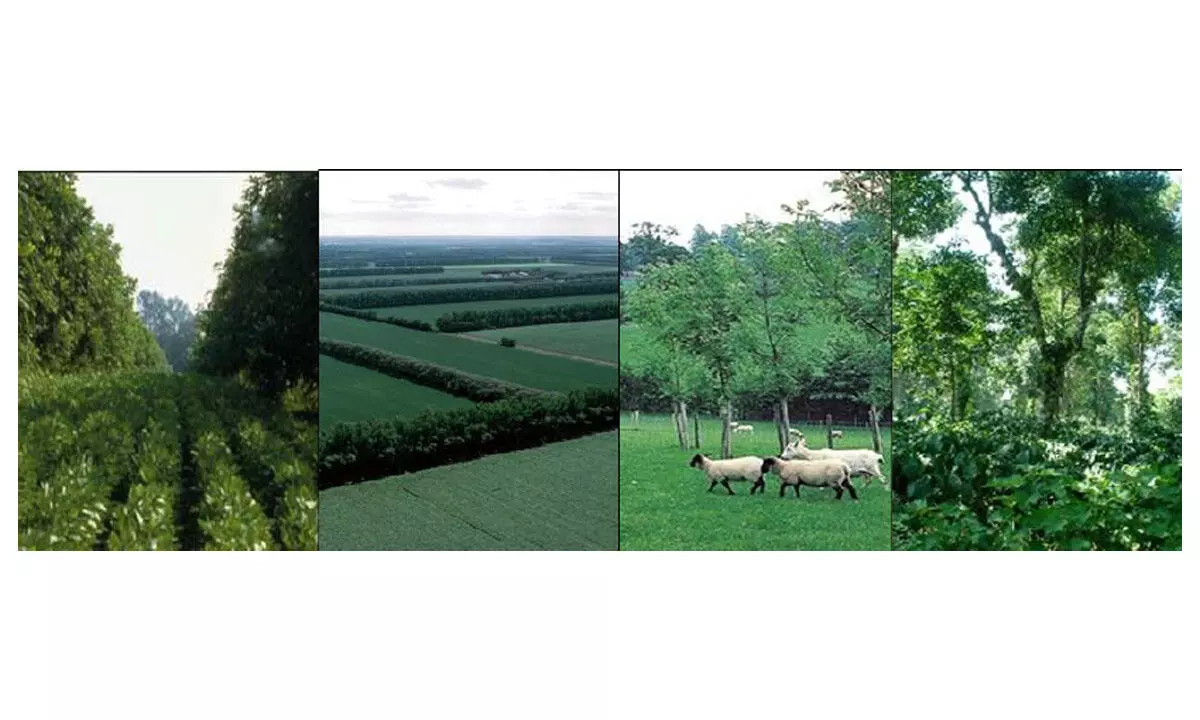Need of Hour: Right interventions

Agroforestry comes to the forefront of discussions with the release of a working paper titled ‘Agro forestry: Missing Trees for the Forest’ released by the Economic Advisory Council to the PM in the last week of September
Agroforestry comes to the forefront of discussions with the release of a working paper titled ‘Agro forestry: Missing Trees for the Forest’ released by the Economic Advisory Council to the PM in the last week of September. Agroforestry is the practice of intentionally combining trees and shrubs with agriculture and animal farming to create environmental, economic, and social benefits. It has been practiced for centuries in the United States and around the world. At present, agroforestry covers around 8.65% of India’s geographical area, spread over about 28.4 million ha, while 16.96% of the area is still categorised as wasteland.
Some valuable recommendations in the paper such as the concept of tree ownership in place of land ownership, use of modern technologies and single window clearance are certain to create positive impact on the agroforestry sector. However, making conservation-oriented forestry and regulatory regime as squarely responsible for limiting agro forestry growth and keeping country import-dependent is not backed by relevant facts and proper evidence. As the recommendations made in this regard do not capture the concerns of various stakeholders other than requirements of the industries, it becomes necessary for wider consultations before they take a shape of an approved policy of the government.
Misconceptions about conservation first approach: The document is premised on a basic tenet that there is tremendous potential for agroforestry growth and the same could not be realised due to stringent regulations and conservation-led forestry. The coverage of about 28 million hectares of tree crops, which is 17% of the cropped area as against the global average of 43% forms the basis for showing under-utilization of potential. This convenient example masks a stunning fact that the per capita agricultural land in our country is far less, that is one-fourth of the global average, thus allowing no digression from placing food production as the topmost priority and providing no room for expansion of agroforestry beyond certain limit. It is a misreading, if someone states that National Forest Policy (NFP), 1988 is aimed at increase of forest and tree cover and restricting to felling of trees outside the forests without the forest department approval. There is not any mention about such legal restrictions in the policy document and they were in existence much earlier to it.
The primary focus of the 1988 policy was to relinquish pro-industry approach and commercial orientation to give way to conservation first approach and sustainable forest management method aiming at environmental stability, ecological security and fulfilment of basic needs of local communities. The policy prescribes discontinuation of forest raw material supplies to industries at concessional rates and compel the industries to meet raw material requirements from alternative sources like captive plantations and/or agricultural lands by forging links with farmers to grow required tree crops. Had this policy not been in place, such a tremendous growth of agro forestry with farmer-industry collaboration (3.9 million hectares of Eucalyptus alone) could not have been possible. But wood-based industries will obviously have issues with this policy as it had put an end to concessional raw material supplies from forest in order to give preference to the needs of the local communities and poor.
The Supreme Court judgement (1996) pertains to imposing restrictions on unregulated felling of trees in notified forests and other non-notified forests with natural growth having ecological significance. This judgement has nothing to do with manmade plantations including agroforestry farms. These two important steps have not only acted as saviours of the environment and natural heritage for greater good of the people but also stimulated the growth of agro forestry by way of reducing competition from supply side on one hand and enhancing the demand for raw materials on the other. Any measures to undo the results of these two land mark initiatives are not only regressive but also counterproductive to agro forestry growth.
Long term native tree crops for agro forestry- relevance: In order to justify deregulation of Teak and other high valued native trees some interesting grounds are shown. These grounds do not stand to reason. First, nativity and the abundance in natural forests need not necessarily favour cultivation by the farmers as the suitability of a species is determined on the basis of various factors such as fast growth, high yields, marketing demand and financial viability. This is the reason why some tree species like Eucalyptus, Poplars, Subabul, Casuarina and other occupy a dominant place in agro forestry though they are not indigenous to the country. It is misleading to say that high price of teak as compared to Eucalyptus for the same unit can result more income to the farmers as both have different maturity periods and Mean Annual Increment (MAI) growth values. Third, the statement that Teak provides an opportunity to push our country from being import-dependent to being an export leader can gain validity only if one can explain as to how the future (anticipated) production that will be after a long period of time can address the present problem of imports.
If Teak cultivation starts now, the yield of low to medium value timber can be expected after 25 to 35 years (For high value it is more than 50 years), provided good inputs and cultural practices are followed. Given, a case study showing the failure of investment based Teak plantations in the past, a cautious approach on promoting teak plantations in private farms especially in the lands of small and marginal farmers becomes necessary. During 1990s around 3,600 plantation companies (Aiyer, 1988) promoted the schemes of planting teak and other valuable long term tree species by mobilising investments from public with an assurance to provide handsome returns from the timber harvested after 20 years. These schemes resulted neither in providing the promised returns to investors nor made a positive socio-economic impact on the rural poor and rural economy (Baloni, 2000).
Past experience of liberalising the regulations – a need for study: The report cites the case of Bamboo which was liberalised from the regulations in 2017 with a principle to promote its production and curb illegal felling as an example to justify similar action for the species like Teak. It would be
useful to launch a detailed study to find out the reasons for resulting into no substantial increase in cultivation and production of Bamboo in farm lands even after seven years and leading to sharp decrease in Bamboo bearing forests to the extent of 10,594 sq KMs from 2019 to 2021 (IFSR, 2021) before suggesting such measures to other species. It is needless to say that Teak with its long growth cycle will have more challenges as compared to Bamboo for attaining success.
Holistic approach – need of the hour: The concerns and needs of 5 million farmers associated with agroforestry (FAO, 2021), traditional wood-based artisans and forest-dependent communities who constitute the primary stakeholder group should take precedence over the demands of industries while working out policy recommendations pertaining to agro forestry. The demands of the farmers include robust mechanism to prevent cartelisation of industries in price determination, introducing price guarantee/minimum support price, strict enforcement of forest laws to arrest illicit leakage of material from forests so as to maintain price stability (Agricultural Marketing Department, 2016).
If there are genuine problems with regard to regulatory regime, certainly there will be ways to address them without harming the long term interests of the environment. There is a great hope that the Authors, who have good reputation in their fields, will exercise their wisdom and revisit the proposal, capture the concerns of all the primary stakeholders and make the recommendations complete, inclusive and holistic one. Let us not forget that saving of natural forests is of paramount importance for the very survival and wellbeing of the present and future generations, livelihood security of the forest dependent communities of 400 million people (TERI, 2015) and for averting catastrophic events like recent Waynad disaster.
(Writer is Former Head of Forest Force, Andhra Pradesh; views expressed are personal)



















